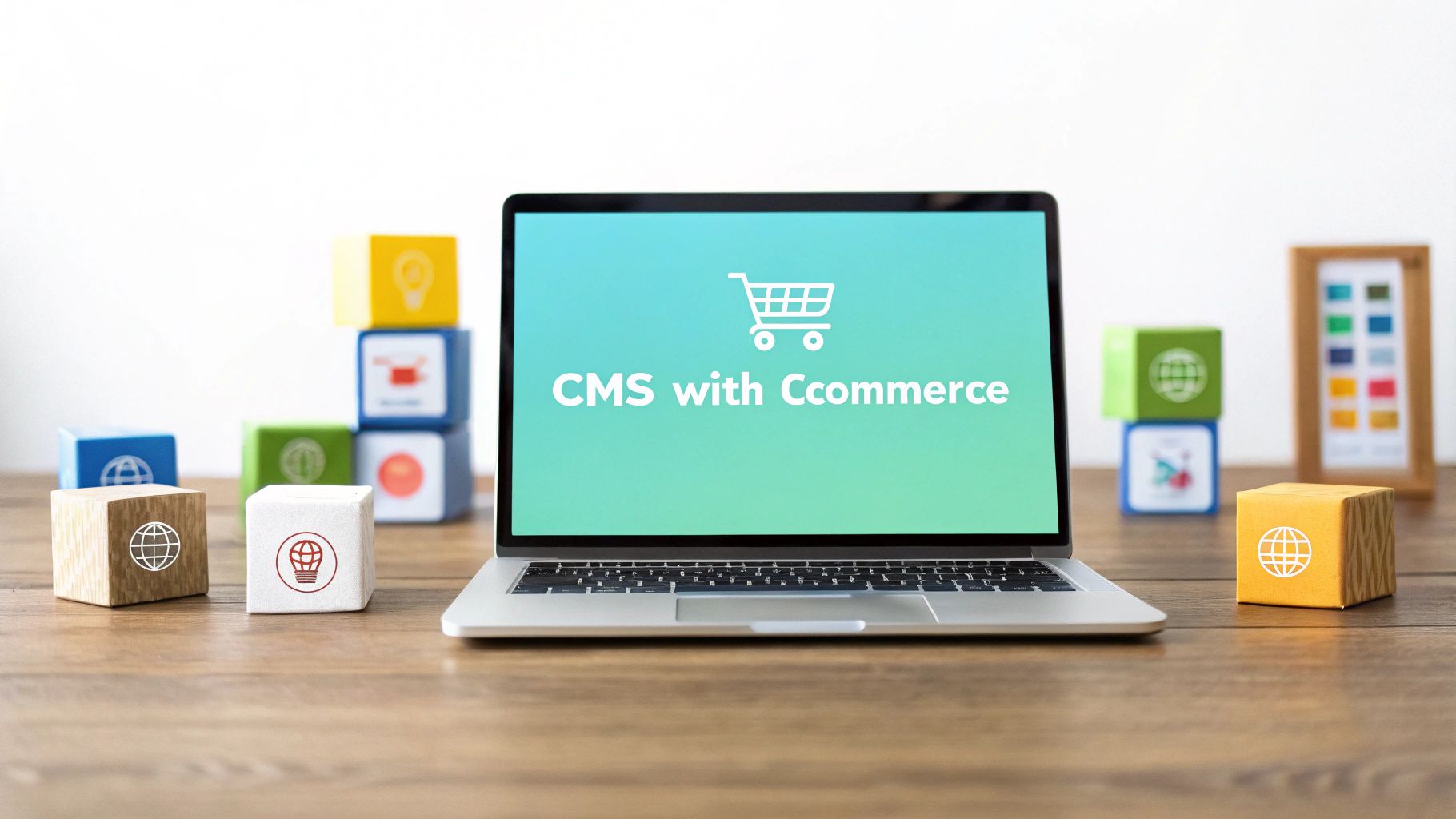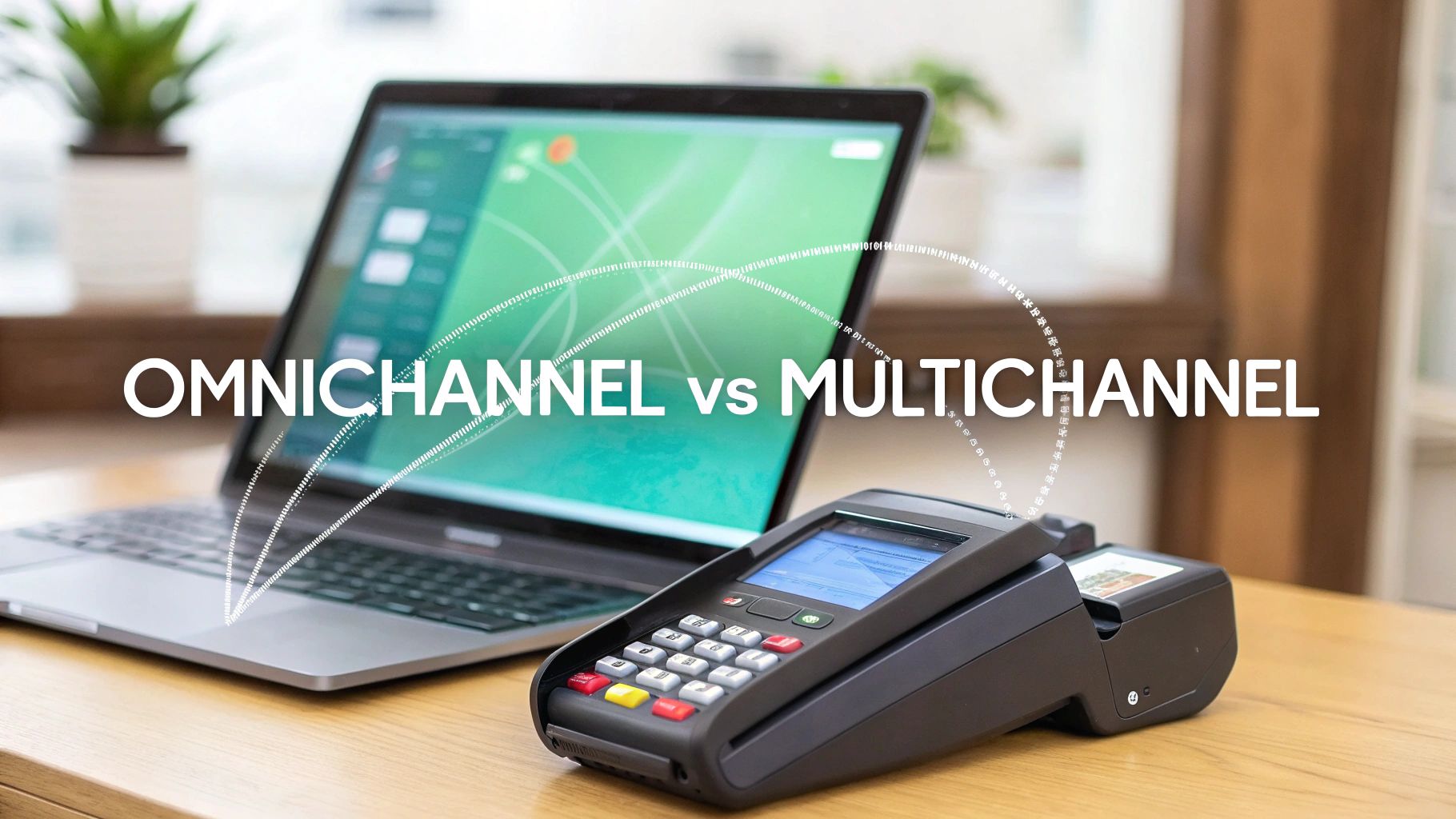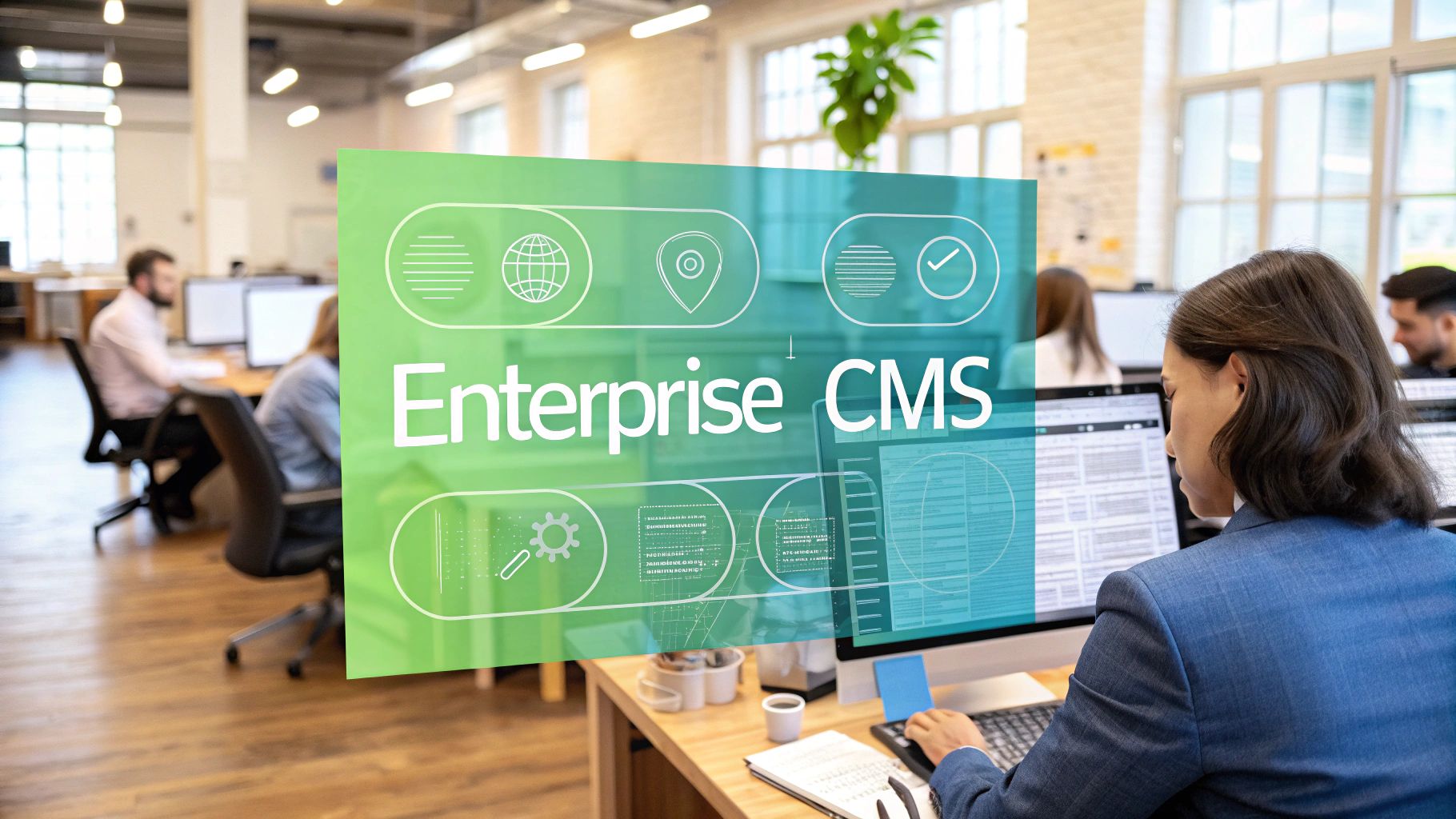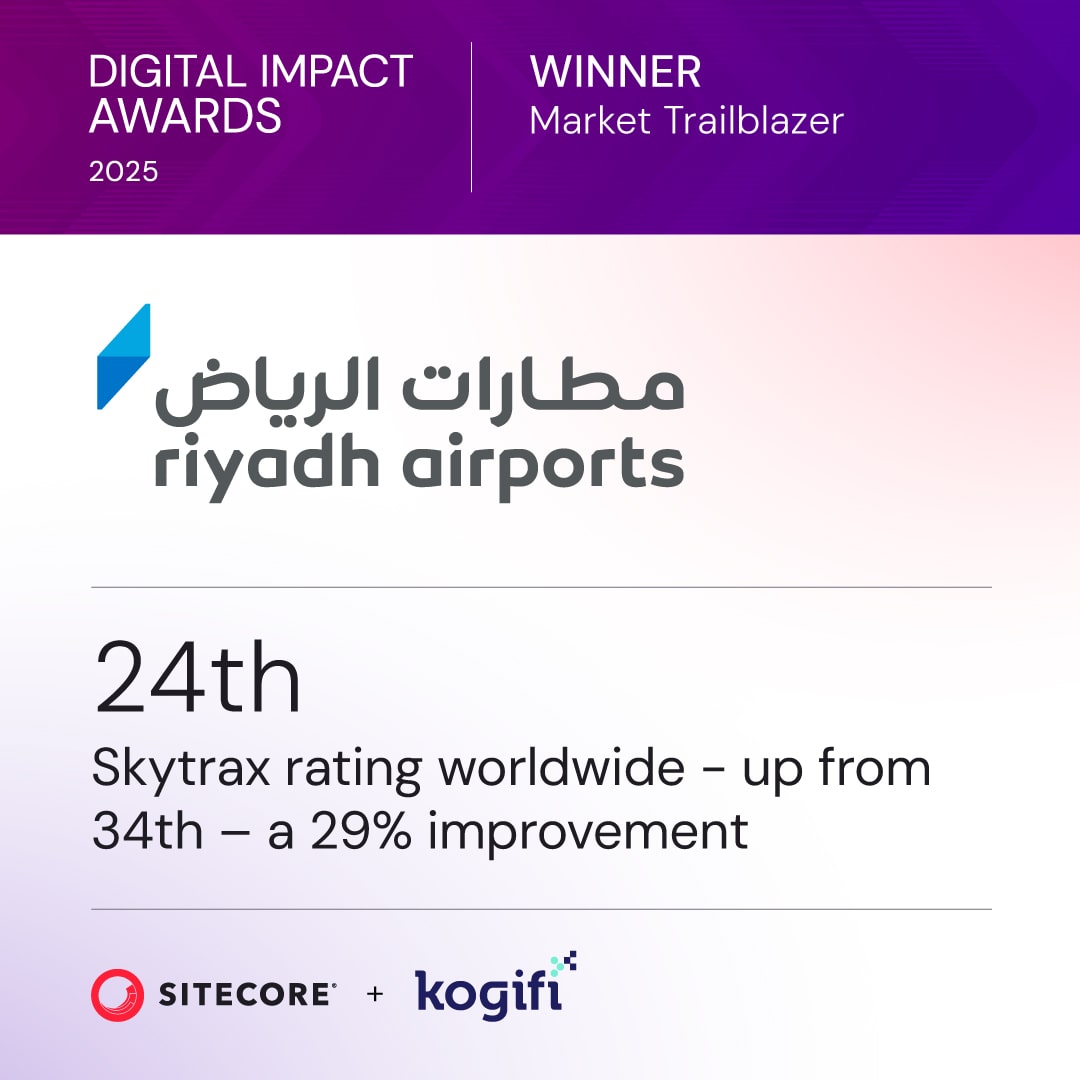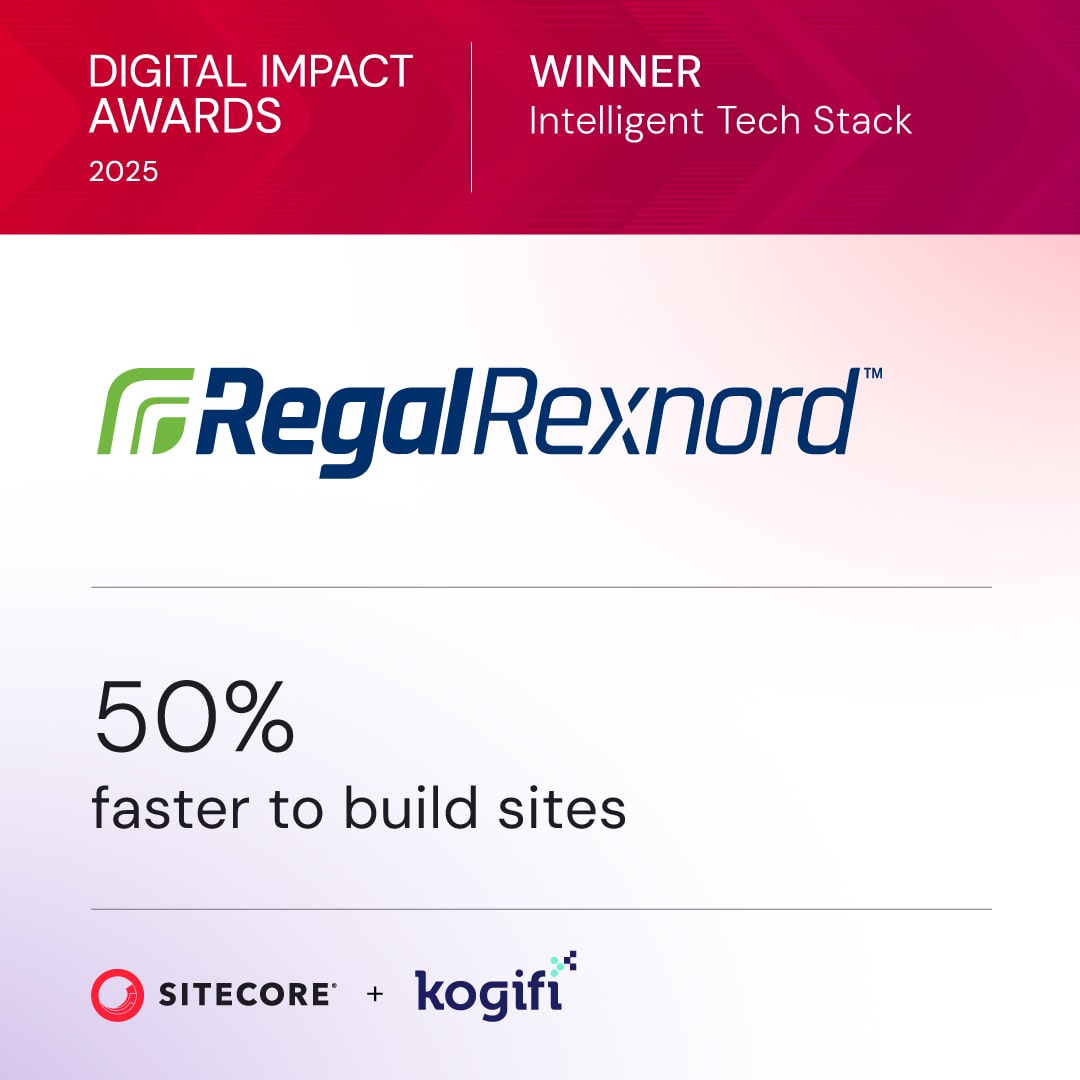A true CMS with ecommerce is far more than just a website builder with a shopping cart tacked on. Think of it as a fully integrated system designed from the ground up to blend compelling content with the ability to buy. It’s what allows businesses to create rich, story-driven shopping experiences instead of just listing products on a page.
The Evolution from Plugins to Platforms
Imagine your digital presence is a high-end retail store. A basic ecommerce plugin is like setting up cash registers in a warehouse—it’s functional, sure, but completely disconnected from the customer experience. A true CMS with ecommerce, on the other hand, acts as the architect, meticulously designing the entire journey from the moment a customer sees the storefront display to the final purchase.
This represents a massive shift from a "bolted-on" approach to a truly unified platform. Modern systems, particularly a Digital Experience Platform (DXP) like Sitecore, are engineered to seamlessly weave brand narratives, personalized content, and commerce together into one cohesive fabric. The goal is no longer just to sell a product, but to create a compelling, revenue-driving experience.
From Separate Systems to a Unified Experience
This unified strategy is the bedrock of modern digital commerce. When your content and commerce platforms operate in separate silos, the customer journey inevitably becomes clunky and fragmented. A great blog post might attract a potential buyer, but if the path to actually purchasing the featured product is clumsy, that sale is as good as lost. An integrated system ensures a smooth, almost invisible transition from inspiration to transaction.
The market trend underscores this shift. The demand for platforms that can manage real-time product catalogs, personalized content, and promotional campaigns in one place is soaring, particularly within the retail and ecommerce sectors. This highlights the critical need for a deeply integrated approach to digital strategy.
Why Integration Matters for Your Business
A platform-first approach, championed by solutions like Sitecore, offers huge advantages over juggling separate, disconnected systems. It's all about creating a single source of truth for both your customer data and your product information, which is the foundation of a sophisticated digital experience.
A modern CMS with ecommerce is a strategic tool for creating cohesive, revenue-driving experiences, not just a technical platform for listing products.
A single, unified system like Sitecore gives businesses the power to:
- Deliver Personalization at Scale: Use real-time customer behavior data from a unified profile to tailor everything from content and product recommendations to special offers.
- Streamline Operations: Manage all digital assets—from blog posts to complex product pages—within one ecosystem, dramatically reducing complexity and improving content velocity.
- Improve Customer Insights: Get a complete, 360-degree view of the customer journey and finally understand exactly how your content influences purchasing decisions.
Integrated vs. Separate Systems
Choosing between a unified system and a separate, plugin-based approach has major strategic implications. A unified platform is built for synergy, while managing separate systems often leads to operational friction and a disjointed customer experience.
Ultimately, the integrated approach creates a powerful engine for growth. By connecting the two worlds of content and commerce, you build a foundation that’s essential for thriving in today’s competitive environment. You can dive deeper into structuring these systems by reading our detailed guide on ecommerce content management.
Choosing Your Commerce Architecture
Picking the right technical foundation for your CMS with ecommerce is one of those big, foundational decisions that shapes everything—from how your developers work to the experience your customers have. The architecture you land on is the blueprint for your entire commercial operation, dictating how flexible, scalable, and ready for the future your platform will be.
For a long time, the go-to model was a monolithic architecture. Think of it like a standard restaurant set menu: the storefront (frontend) and all the business logic (backend) are bundled into one tightly connected package. It’s straightforward, sure, but this all-in-one approach can feel restrictive. Trying to innovate or change one part often means messing with the whole system.
This infographic shows the relationship at the heart of a modern ecommerce CMS, where content and commerce are two sides of the same coin.
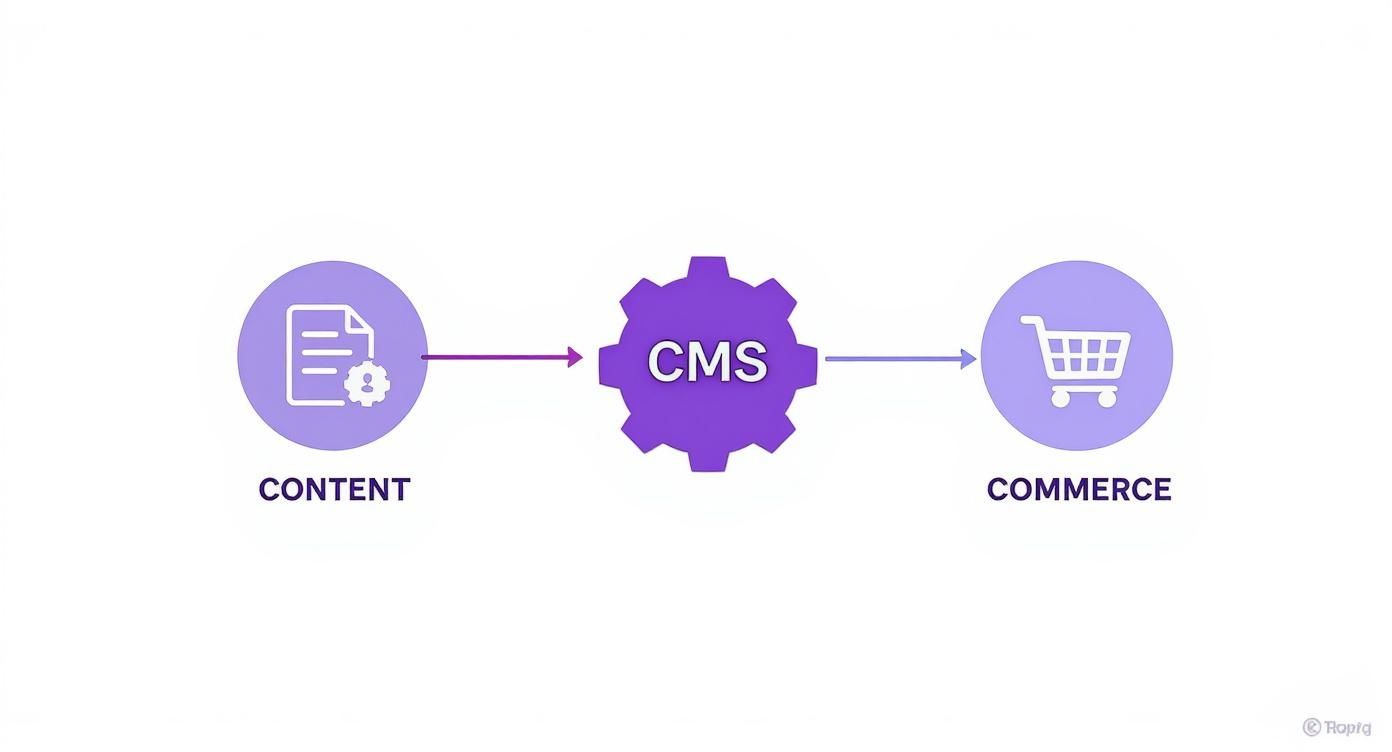
You can see how a central CMS drives both content and commerce, allowing for a truly unified strategy.
The Rise of Headless and Composable Commerce
Today, modern platforms like Sitecore are moving toward headless and composable architectures. If the old way was a set menu, this is like dining à la carte—you get to pick and choose the best of everything. A headless architecture essentially "decouples" the backend body (your content, commerce engine, and logic) from the frontend "head" (the actual website, mobile app, or even a smart kiosk).
This separation is incredibly powerful. It means you can use a best-in-class commerce engine like Sitecore OrderCloud to handle all your products, pricing, and orders, while your marketing teams use a powerful CMS like Sitecore XM Cloud to create incredible experiences. The two systems talk to each other through APIs, giving you an amazing amount of flexibility.
A composable DXP frees you to select the perfect 'head' or frontend for any channel—be it a website, a mobile app, or a smart kiosk—without being locked into a single presentation layer.
Why a Composable Approach Wins
A composable strategy pushes this idea even further. It lets you assemble your entire digital experience platform from a series of independent, best-of-breed services. This "pick and mix" approach delivers some serious business advantages.
- Accelerated Innovation: Your teams can work on the frontend and backend at the same time, which dramatically slashes the time-to-market for new features and campaigns.
- True Omnichannel Delivery: You can push the same product information and content to any channel—from a responsive website to an in-store display—creating a consistent brand experience everywhere.
- Future-Proof Flexibility: Need to swap out a payment gateway or a search provider? No problem. You can easily switch individual components without having to rip apart your entire platform.
This modular structure is the secret to real digital agility. To get a better sense of how these pieces fit together, it’s worth digging into the concepts behind an ecommerce microservices architecture, which is really the bedrock of composable commerce. By embracing this model, you can build a resilient, scalable system that’s ready for whatever comes next.
Powering Experiences with Sitecore Commerce
While plenty of platforms can help you sell products online, the Sitecore ecosystem is built for something different entirely. It’s designed to unify content and commerce so seamlessly that your customers won't even see the line between them. This isn't just about bolting a shopping cart onto a CMS; it's about creating a true Digital Experience Platform (DXP) where every blog post, video, and landing page can guide a customer toward a purchase.

This strategic approach is exactly what positions Sitecore as a leading cms with ecommerce for ambitious enterprises. The goal is to get away from static product grids and build dynamic, personalized shopping journeys that react to what each user does in real time.
The Synergy of XM Cloud and OrderCloud
At the heart of Sitecore’s modern, composable stack are two API-first products that work in perfect harmony: Sitecore XM Cloud and Sitecore OrderCloud. Each one is a specialist, handling what it does best.
- Sitecore XM Cloud (The CMS): This is your content and experience hub. As a cloud-native, headless CMS, it gives marketers the speed and agility to create and deploy compelling content everywhere.
- Sitecore OrderCloud (The Commerce Engine): This is your powerhouse, headless commerce platform. It’s built to manage all the complex business logic—from product catalogs and pricing to inventory and order fulfillment—for any model, whether you're B2B, B2C, or running a marketplace.
Think of XM Cloud as the brilliant storyteller crafting the narrative and OrderCloud as the robust commercial engine making the sale happen. Together, they let you present a powerful brand story on any channel, knowing the transaction behind it is smooth, secure, and ready to scale.
From Personalization to Business Outcomes
The real magic happens when you combine this integrated system with Sitecore's personalization engine. Because all your content and commerce data lives in the same DXP, you can achieve a level of targeting that simpler, siloed platforms just can't touch.
Imagine a visitor reads a few articles on your site about high-performance running shoes. The system recognizes this interest and automatically serves them a personalized hero banner on the homepage featuring your latest marathon-ready models. If they add a pair to their cart but leave, you can trigger a follow-up email with a helpful guide like, "Choosing the Right Running Shoe for Your Gait," gently nudging them back to complete the purchase.
By connecting user behavior directly to commercial actions, Sitecore transforms the website from a simple sales channel into an intelligent, experience-driven revenue engine.
This isn’t just about making the site feel more personal; it drives real business results. Companies that get this right see tangible improvements in key metrics like conversion rates, average order value (AOV), and customer lifetime value (CLV).
A Platform Built for Enterprise Ambition
Sitecore is purpose-built for enterprises where the customer experience itself is the main competitive advantage. Its architecture is engineered to handle massive complexity, global scale, and the deep integrations large organizations depend on. While other platforms serve different market segments, Sitecore's focus is on providing the robust, scalable, and flexible foundation required for complex digital transformation projects. By embracing a composable, API-first model, Sitecore gives you the foundation you need to enable innovation in ecommerce and adapt to whatever the market throws at you next, without getting locked into a rigid, all-in-one system.
Integrating SharePoint for B2B Commerce
Let's be clear: SharePoint isn't your typical ecommerce platform. But for businesses already running on the Microsoft ecosystem, it can be a surprisingly powerful tool for B2B and internal commerce. Think of it less as a storefront and more as the foundational layer for complex sales operations.
Its real strength lies in areas where B2B deals get messy—document management, complicated approval workflows, and secure partner collaboration. SharePoint is built to handle the mountain of contracts, technical specs, and compliance paperwork that often comes with a high-value B2B purchase. You're not replacing a commerce engine; you're supercharging it.
The Content and Collaboration Layer
The smartest way to use SharePoint for commerce is as a content and collaboration layer that plugs into a dedicated, headless commerce engine. In this model, SharePoint acts as a secure portal. This is where your partners or high-value clients log in to see their specific pricing, review contracts, and work directly with your sales team.
Behind the scenes, a headless commerce platform like Sitecore OrderCloud manages the actual transactions, inventory, and fulfillment. The two systems talk to each other through APIs, creating a seamless experience. All the complex relationship management happens in SharePoint, while the nuts and bolts of the purchase are handled by a specialized commerce tool. It’s an architecture perfectly suited for the long, winding road of B2B sales.
By combining SharePoint's collaborative strengths with a dedicated commerce engine, businesses can create highly specialized procurement portals that streamline complex B2B purchasing processes.
Real-World B2B Use Cases
This integrated approach opens the door to powerful applications that a standard ecommerce platform just can't support on its own. It's a crucial part of building a smart CMS with ecommerce strategy designed specifically for B2B realities.
- Internal Procurement Portals: Employees can order approved equipment and supplies from a user-friendly SharePoint portal. All the purchasing rules and multi-step approval workflows are managed seamlessly in the background.
- Secure Partner Sites: Imagine a secure hub where your distributors can access personalized product catalogs, see custom pricing pulled directly from their contracts, and place bulk orders. All their sales collateral and training materials are right there, too.
- Complex Contract Management: For industries with long sales cycles and heavy negotiations, SharePoint can manage the entire contract lifecycle. Once a contract is approved, its terms can be linked directly to the customer’s purchasing power in the commerce engine.
For any organization looking to build these kinds of sophisticated B2B solutions, understanding what the platform can really do is the first step. You can dive deeper into its capabilities in our expert overview of SharePoint development. This integrated model transforms a familiar internal tool into a powerful engine for driving B2B revenue.
How to Select Your Ecommerce CMS
Picking the right platform is a major business decision, not just a technical task. It’s about finding an engine for long-term growth, which means you need a solid framework for evaluating any enterprise-grade CMS with ecommerce. The key is to find a sweet spot that satisfies both your business leaders and your tech teams.

The significance of this decision is amplified by market growth, with an increasing number of businesses relying on dedicated platforms to power their online operations. Choosing the right one is foundational to digital success.
Key Business Evaluation Criteria
From a business perspective, it's all about growth, efficiency, and the customer experience. Your platform needs to be a revenue driver, not just another line item on the expense report.
- Total Cost of Ownership (TCO): Don't just look at the initial licensing fee. You need to factor in the costs of implementation, ongoing maintenance, the expertise your team will need, and any future upgrades.
- Scalability for Growth: Think about your five-year plan. Can this platform handle a massive spike in traffic during a holiday sale? Can it support a bigger product catalog or expansion into new global markets without needing a complete overhaul?
- Omnichannel Personalization: Today's customers interact with brands across web, mobile, and even in-store. Your system has to deliver a consistent, personalized experience no matter where they are. Platforms like Sitecore are masters at using customer data to weave these connected journeys together.
Essential Technical Considerations
For the tech team, the focus is on a platform that's robust, secure, and flexible. The right architecture empowers developers to build and innovate, not fight against limitations. An often-overlooked but critical technical piece is payment processing; you can get a head start by reviewing best practices for choosing the best payment gateway for ecommerce.
Looking beyond a simple feature list is essential. The right platform must align with your long-term digital transformation strategy, supporting both current needs and future ambitions.
Here’s what a strong technical foundation looks like:
- Architectural Flexibility: Does it support a headless or composable approach? This is huge. It gives your developers the freedom to choose the best front-end technologies and plug in other best-of-breed services without being locked into a monolithic system.
- Integration Capabilities: Your CMS doesn’t live on an island. It has to talk to your other enterprise systems—like ERP, CRM, and PIM—without a hitch. Rock-solid API support is non-negotiable.
- Security and Compliance: Protecting customer data is paramount. The platform must adhere to strict security protocols and industry standards like GDPR and PCI DSS to build and maintain trust.
To tie this all together, here is a practical checklist to guide your team through the evaluation process, making sure you cover all the critical business and technical angles.
Enterprise Ecommerce CMS Evaluation Checklist
This checklist is a starting point, but it forces the right conversations between business and IT. By asking these questions, you ensure that the platform you choose not only meets your technical requirements but also becomes a powerful engine for achieving your strategic business goals.
Measuring Success and Calculating ROI
Putting a sophisticated CMS with ecommerce into place is a serious investment, and you absolutely have to prove its worth. Success isn't just about watching revenue climb; it's about seeing exactly how your content and commerce engines are working together to drive profitable growth. This means you need to look past the obvious metrics.
You have to be able to draw a direct line from a piece of content to a purchase. This is where platforms like Sitecore really shine, giving you analytics that trace a customer's entire journey—from the blog posts they read to the final click of the "buy" button. It’s this kind of insight that reveals the true power of your content strategy.
Key Performance Indicators For Content-Commerce
To get the full story, you need to zero in on the key performance indicators (KPIs) that truly reflect the health of your integrated strategy.
- Average Order Value (AOV): Are those personalized content recommendations actually prompting customers to add more to their carts? A rising AOV says yes.
- Customer Lifetime Value (CLV): Good content builds loyalty. Track CLV to see if your efforts are creating repeat customers who stick around for the long haul.
- Content-Led Conversion Rates: Isolate the conversion rates for users who followed a specific content path before buying. This tells you which articles, videos, or guides are your heaviest hitters.
When you can connect content consumption directly to commerce outcomes, you can calculate a clear Return on Investment (ROI). This is what empowers you to fine-tune your digital strategy for even better results.
To truly master this, it's worth digging into different strategies for measuring marketing ROI. Applying these principles will help you prove the financial impact of your platform and make a rock-solid case for future investments in the customer experience.
Frequently Asked Questions
We get asked a lot about the nitty-gritty of putting a CMS and an ecommerce engine together. Here are some of the most common questions, answered based on our years of experience in the trenches with platforms like Sitecore.
Headless vs. Traditional CMS for Ecommerce
Think of a traditional CMS as an all-in-one package deal—the backend where you manage content and the frontend website your customers see are tightly connected. It's often simpler to get started with, but that simplicity comes at the cost of flexibility.
A headless CMS, which is the philosophy behind modern Sitecore, is different. It separates, or "decouples," the backend content hub from any single frontend. This means you can use the same product information and marketing content to power your main website, a mobile app, an in-store kiosk, or whatever new channel comes next. It’s the only real way to build a true omnichannel experience and stop your platform from becoming obsolete in a few years.
How Does Sitecore Personalization Actually Improve Ecommerce Results?
Sitecore’s personalization goes way beyond just greeting a returning visitor by name. It’s constantly watching and learning from every single interaction—what pages someone views, which whitepapers they download, and the products they click on. This builds a unique, real-time profile for each visitor.
Then, it puts that data to work, instantly changing what that person sees. It might swap out a generic homepage banner for one that matches their industry or show them blog posts related to a product they were just browsing. This kind of 1:1 personalization is incredibly powerful. It grabs attention, keeps people engaged, and directly translates into higher conversion rates and bigger average order values.
By using behavioral data to dynamically alter the user experience in real time, Sitecore helps businesses deliver the right message to the right customer at the exact right moment, turning passive browsing into active purchasing.
Can We Migrate Our Existing Product Catalog?
Absolutely. Migrating your existing product catalog isn't just possible; it's a standard and crucial part of any new platform implementation. Modern, API-first commerce platforms like Sitecore OrderCloud are built from the ground up to make this kind of integration as smooth as possible.
The process usually starts by exporting your product data from the old system into a standardized format like CSV or JSON. From there, we use OrderCloud's powerful APIs to import that data and map it to the new structure. A good implementation partner will manage this whole process to guarantee no data gets lost, minimize any downtime, and navigate the tricky parts, like handling custom product attributes or complex pricing rules.
Ready to build a powerful, unified digital experience? The experts at Kogifi specialize in implementing advanced Sitecore and SharePoint solutions that turn your digital vision into a commercial reality. Contact us today to start the conversation.

















